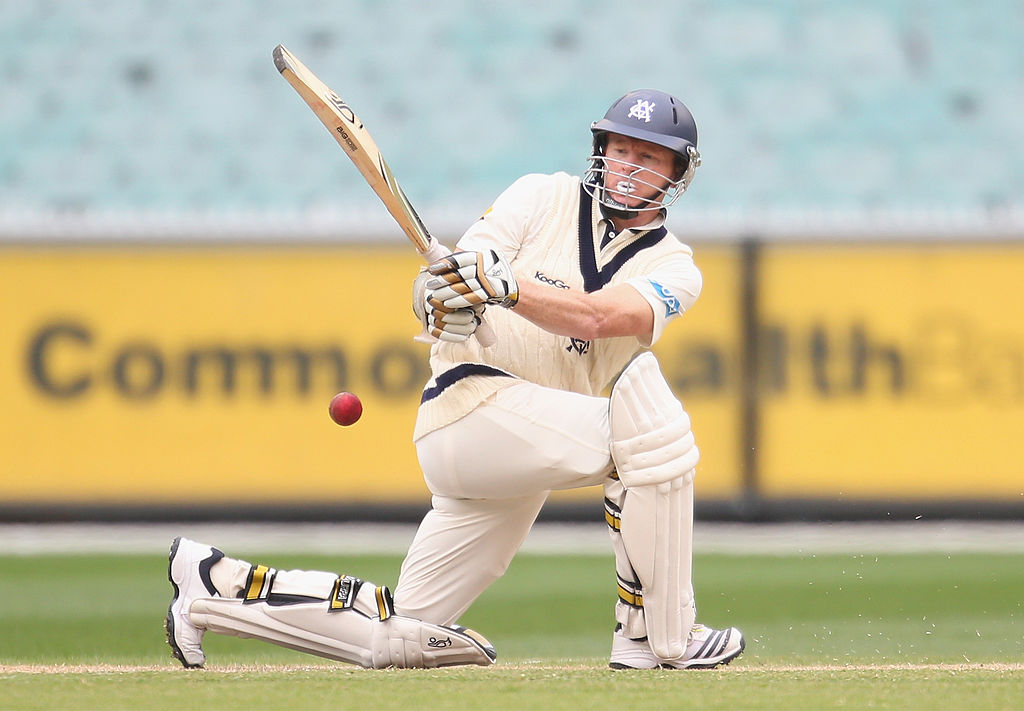“The Dukes ball tends to dart at you” - Chris Rogers on the challenge of opening the batting in England
By the time he was a regular in the Test team, he was 36 years old. He represented Australia in just 25 Tests in his career. Yet, with his uncanny technique and ceaseless consistency, Chris Rogers left a perpetual mark on the minds of every single person who watched him bat.

Perhaps nothing summarizes Chris Rogers’ career better than the fact that he scored twin centuries in his last ever professional game - with the last ton being an unbeaten one. A stylish left-handed opener who loved to bat, Rogers amassed more than 25,000 runs in his first-class career, a tally that is bettered by not many. If there ever was a living example for the word “late bloomer”, he is it, making his international debut at 31 years of age and still excelling at levels many could only dream of.
Between December 2014 and July 2015, Rogers scored 7 consecutive half-centuries - a record which is yet to be broken by any batsman. By the time he hung up his boots in 2015, the veteran batsman was 38 years of age. But then again, the sport is inseparable from some cricketers, and Rogers is certainly one of them. The left-hander was recently in charge of the Australian National Performance Squad that held a camp at the MRF Pace Academy in Chennai, overlooking the batsmen who came to learn their trade in the dust bowls of Chennai against budding local talents.
Speaking exclusively to SportsCafe last week, Rogers said that the training camp served as a golden opportunity for the Aussie youngsters to learn the art of playing spin, given that they’re prepared to make mistakes in order to mould themselves into better batsmen. He also said that the primary reason for arranging the camp was the sheer amount of cricket Australia play in the sub-continent, which in turn demands batsmen to hone their skills in various departments, none so more than playing against spin.
“I think we looked at the statistic which showed that the Australian cricket side play a ridiculous amount of cricket in Asia. So we as a nation are going to be facing these conditions a lot more,” Rogers told SportsCafe.
“We've also found through a lot of data that we play spin differently to Indian batsmen in particular. They tend to hit the ball deeper in their crease and get a little bit further down (the track) and I think that's just due to growing up in these conditions and being challenged.
“For us to come over here particularly on a development tour where the batsmen are prepared to make some mistakes to get better is priceless,” he spoke of the camp.
This is also the second time in as many years that the 41-year-old has travelled to Chennai as a mentor for the young batsmen. Rogers exclaimed that the experience gained from their previous camp turned out to be invaluable for the batters, while also praising the MRF Foundation bowlers for their skills, expressing his contentment over the development within the academy.
“The guys play against spin on spinning pitches but they are also here playing against the MRF Pace Foundation fast bowlers who are pretty quick, to be honest, so there is some all-round great development over here.
“This is the second time I've been here as a coach and I can guarantee you that the first time around the guys got so much out of it. Already looking at today, you can tell that the guys are enjoying the challenge.”
If you’re a veteran in the domestic circuit, chances are that you would have played a lot of English county cricket and Rogers is no different. From 2004 to 2016, the opener represented a vast variety of English clubs, including Middlesex, Somerset, Leicestershire, Derbyshire and Northamptonshire. Incidentally, his twin tons in his last ever first-class game also came for Somerset against Nottinghamshire.
As a batsman, one of the toughest challenges in the world is opening the batting in England against a brand new Dukes ball. Even the best of the best have struggled to conquer the challenge, and Rogers, having almost done the same task for a living, has his own reasoning and explanation as to why it is such a daunting task to come up against a brand new seed in English conditions.
“Yes, it swings, but the other thing that happens with the Dukes ball in England is that it tends to dart at you. It tends to almost have a radar on your front pad so sometimes it almost feels as if the ball is gathering off the pitch.
“The ball tends to bounce quite truly in Australia and you can leave on length whereas in England the ball tends to nip hard at you and can kinda beat you for pace a lot of the times and so that's a different kind of challenge.
“In Australia, you're probably playing a lot more off the backfoot while in England it's all about the ball kinda hitting your front knee-roll and that can be challenging, particularly for an Australian.”
Through Rogers’ own words, one can interpret why the Australian batsmen have struggled in this Ashes so far. However, unsurprisingly, one man has stood tall and has put England to the sword whenever he’s batted. With scores of 144, 142 and 92, Smith has been head and shoulders above any batsmen in the series, averaging an astonishing 126.
But the New South Welshman also notched up two daddy hundreds - 215 at Lord’s and 143 at The Oval - in 2015, and incidentally, Rogers was at the non-strikers’ end during Smith’s knock at Lord’s. When asked to rate and compare the 2015 hundreds with the 2019 ones, Rogers said that he rated the latter higher purely because of the situation of the innings and the magnitude of the occasion, which saw Smith come in with his team 17/2 and 27/2, under immense pressure.
“I think these innings, particularly the first innings in the first Test at Edgbaston is the one that stands out just because he was in quite early. He was in within the first 10 overs and therefore had to do a lot more work against the newer ball when it was swinging.
“I think both the innings in 2015 at the Lord's and The Oval he probably came in a little bit later so I think this in terms of the level of difficulty was much higher and he's set the standard in the very first Test helping Australia to take a 1-0 lead and I think if you get that win in the very first Test of the series, it sets the standards for the rest of the series.”
From Glenn Mcgrath to Shane Warne to Dale Steyn to James Anderson, Rogers has faced an array of world-class fast bowlers in his career, thanks to his stints with various clubs around the world. However, the southpaw has singled out England’s Graeme Swann as the toughest bowler he faced in his career.
The off-spinner dismissed Rogers 7 times in his career, including the infamous dismissal at Lord’s in 2013 where the latter was ruled LBW after missing a high full-toss. The Australian spoke about his troubles facing Swann, admitting that he was playing ‘french cricket’ trying to counter the Englishman’s threat.
“Full toss, yeah yeah yeah. We won't talk about that one (chuckles)” said Rogers, when I cheekily reminded him about the Lord’s dismissal.
“I had to name the best XI I've ever played with/for/against and I named Graeme Swann as one of them and I got ridiculed a little bit for it because he probably doesn't compare to Warnie (Shane Warne) in many respects but I just found himself so difficult, he just got me out. I couldn't score off him.
“I just found him extremely hard. His seam position always angled towards first slip kinda second slip. Some balls would spin, some balls would skid, but you never quite knew. I just felt like I was playing French cricket out there trying to block it and not get out instead of looking to score and it was quite difficult.”

Comments
Sign up or log in to your account to leave comments and reactions
0 Comments